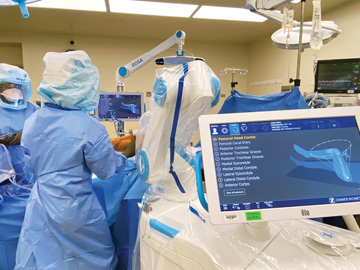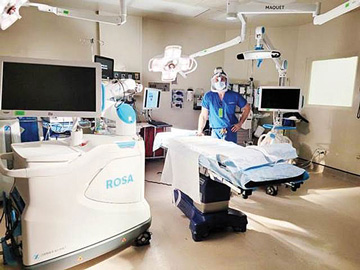More than one million joint replacements are performed each year and increasing numbers of surgeons are opting to do them with the benefit of robotic assistance. I’ve been in practice for over 10 years and recently launched the robotics program at Montefiore Medical Center in the Bronx — a move made in response to market pressure and to provide cutting-edge care. It’s essential to remain at the forefront of orthopedic offerings to advance hip and knee replacement surgery, especially when your facility will capture more cases and provide patients with improved outcomes.
- Home
- The Magazine
- Article
Strategies for Success in Total Joints
By: Carlos M. Alvarado, MD, FAAOS
Published: 10/14/2021
Identifying the best candidates for surgery and outfitting your ORs with state-of-the-art technology is a winning recipe.
Improved accuracy
Most orthopedic surgical robots on the market have a large mechanical arm that resembles robotic arms used in automated manufacturing plants. Sensors are attached with small pins to bones around the joint that’s being replaced. During a hip replacement, for example, pins are attached to the pelvis and femur. Those pins tell the robot where the bones are located and where cuts need to be made. The robot can identify exact angles of cuts that need to be corrected in real time, a feature that is very helpful in placing implants more precisely in patients who are obese or have joint deformities. There is a higher risk of malpositioned implants during conventional surgery in these patients, so the robot allows for more accuracy and precision. Setting up the robot adds a couple minutes to the surgery, but once the pins are attached, the calculations are essentially instantaneous.
Although the robot helps me place standard implants precisely and accurately, I can also use custom implants based on 3D models of a patient’s specific anatomy. Pre-op CT scans of the patient’s leg and joint are sent to the manufacturer of the implants. In five to six weeks, we receive the 3D-printed customized implant and the custom tools with which to implant it. The tools arrive in a single tray, which cuts down on the number of instruments scrub techs need to manage and reprocessing techs need to clean and sterilize.
I recently took care of a young patient who had suffered a knee fracture, which caused deformity in the joint, from falling off a ladder. He couldn’t bend his knee or play with his kids, the things we take for granted when we’re healthy. I replaced his knee using the robot and the joint’s motion improved just a few weeks after surgery. The patient had six plates and screws in and around his knee because of the injury, and the custom-made implants helped me work around the existing hardware without a significant amount of dissection.
The use of customized implants improves workflow in the OR, doesn’t add time to procedures or impact outcomes — in fact, we see a trend toward less intraoperative bleeding. Revision surgeries are needed after 1% to 2% of traditional total hip and knee replacements, and patients are dissatisfied with the outcomes of non-robotic joint replacements 10% to 15% of the time. These figures suggest the increased accuracy afforded by robotics could lead to better outcomes and improved patient satisfaction. Although there is no specific data on increased success rates with the technology, in the long term it may result in fewer revisions needing to be performed.
Patient selection

All chronic medical issues need to be optimized prior to joint replacement surgery. Patients with diabetes must get their HbA1c numbers to an appropriate level. Patients who are overweight, which is a common problem in the U.S. and one of the reasons we’re seeing more patients suffering from hip and knee arthritis, must lose weight before surgery. Providers need to identify patients on chronic medications such as narcotics and try to minimize their use.
The ideal patient is healthy but limited due to pain and joint dysfunction, and who has already tried conservative pain management techniques. They want to undergo elective joint replacement to improve their quality of life.
Post-op lengths of stay following joint replacement surgery have decreased significantly throughout my career; 20% to 40% of patients are able to go home the day of surgery, with most going home within a day-and-a-half.
There are certain patients who would benefit the most from having their joints replaced with robotic assistance, such as those who have a higher risk of post-op complications due to malpositioned implants — as mentioned, obese patients and patients with joint deformity caused by previous surgery or injury. Hip replacement patients who have undergone lower back surgery or who have degenerative bone disease may benefit from customization or robotic surgery as they have a higher risk of malposition of the implant’s components, which can result in dislocation.
Future investment

Robotics is a relatively new technology that has grown in popularity over the past five years. Just in the last year and a half, we’re seeing the trend toward improved outcomes, decreased revisions and fewer repeat surgeries. However, there is a learning curve involved; it takes around 20 cases for surgeons to feel completely comfortable with the technology, a threshold that can be achieved in a month for a busy surgeon.
Robotic platforms cost about $1 million. My practice has demonstrated that the technology results in more accurate implant placement and therefore potentially better results. As patients become savvier and more aware of the benefits of robotic-assisted surgery, the facilities that invest in the technology will be able to market themselves as joint replacement leaders within their local communities.
Robotic platforms also allow surgeons to accurately record intraoperative data that captures every movement and every cut. It helps them identify the patients who achieve excellent outcomes and who would benefit the most from robotic surgery, as well as the variables associated with positive results. In these ways, robotic assistance will help advance the techniques and outcomes of joint replacement surgery.
A quarter of orthopedic surgeons are in the second half of their careers, and this technology is new to many of them. They’ve been performing joint replacements for four decades with good success, usually hovering around 85% to 95%. It’s hard to improve on that high rate of success; building a better mousetrap is a tough thing to do.
Your facility needs to position itself for the future of joint replacement surgery, which will no doubt involve surgeons interested in using robotics to continually push for perfection. OSM
.svg?sfvrsn=be606e78_3)
.svg?sfvrsn=56b2f850_5)